Research on the Performance of Recycled-Straw Insulating Concrete and Optimization Design of Matching Ratio
Abstract
1. Introduction
2. Materials and Testing Procedure
2.1. Materials
2.2. Orthogonal Test Design
2.3. Test Preparation and Performance Testing
- Natural aggregate, recycled coarse aggregate, and sand were placed into the concrete blender for mixing, and half of the required water was added.
- Straw fibers were added while stirring, and they were stirred for 30 s after all the straw was added.
- Cement and fly ash were added and stirred for about 1 min. Then, the remaining half of the water was added and stirred for 2–3 min.
- The mixture of concrete was poured into a mold and demolded after 48 h. The concrete test specimens were kept in a standard maintenance room at 20 ± 2 °C and 95% humidity. The compressive strength test was conducted after 7 d and 28 d of standard maintenance. Then, the thermal conductivity test was conducted after 28 d of standard maintenance.
- The specimens were removed from the curing room. Then, we wiped the attached water off the surface of the specimen with a wet wrung-out washcloth.
- The specimens were placed in the center of the lower pressure plate surface of the testing machine. Then, we started the testing machine.
- For uniform and continuous loading in the test process, the loading speed was set at 0.4~0.6 MPa per second. Compressive strength was recorded until the specimen was damaged.
- Specimens were kept in the curing room for 28 d and then placed in the dryer at 105 °C to dry to constant weight.
- After the dried specimens cooled to room temperature, the cold plate temperature of the thermal conductivity tester was set to 15 °C, and the hot plate temperature was set to 35 °C. The specimens were then tested for thermal conductivity.
- After the test data stabilized, records were taken and organized.
2.4. Finite Element Simulation of Wall Temperature Field
- Establishing the model of recycled-straw insulating concrete wall: in the geometric modeling platform of Design Modeler in the software, the dimensions of the recycled-straw insulating concrete wall model were established as 2 m high, 1 m wide, and 0.3 m thick.
- Creating a steady-state thermal analysis project: the recycled-straw insulating concrete wall model established in the Design Modeler module was imported into the steady-state thermal analysis system.
- Assigning material properties: Concrete materials were searched for in the engineering data of the software, and their performance parameters was added. The main performance parameter was the setting of concrete thermal conductivity. For the steady-state thermal analysis simulation process of the straw concrete wall, 16 groups of materials were set.
- Meshing of recycled-straw insulating concrete wall models: the automatic meshing method was used, which can automatically identify the object and match the appropriate meshing form, and the model mesh was generated with 188,232 cells and 43,287 nodes after automatic meshing.
- Adding load: The steady-state temperature field simulation of the recycled-straw insulating concrete wall was preset on the outer side of the wall. For the outer surface of the wall, the outdoor ambient temperature was set to 0 °C with temperature transfer. A temperature load was applied to the interior surface of the wall, and the heat flux was set to 40 W/m2. The remaining four surfaces of the wall were assumed to be insulated.
- Solving: the solving option was set to achieve the purpose of the data results we wanted to obtain from the simulation.
3. Results, Analysis, and Discussion
3.1. Results
3.2. Analysis and Discussion of Mechanical Properties
3.2.1. Range Analysis
3.2.2. Variance Analysis
3.3. Analysis and Discussion of Thermal Conductivity
3.3.1. Range Analysis
3.3.2. Variance Analysis
3.4. Optimal Design of Mix Ratio
3.5. Finite Element Simulation Analysis of Wall Temperature Field
4. Conclusions
- For mechanical properties, the degree of influence falls into the order of straw > recycled aggregate > fly ash. For the thermal properties, the order of influence is recycled aggregate > straw > fly ash.
- The optimal mix ratio for recycled-straw insulating concrete falls into Group 12, which has a recycled coarse aggregate replacement ratio of 70%, fly ash replacement ration of 20%, and straw content of 1%. This mix ratio results in a compressive strength of 30.93 MPa and a thermal conductivity of 0.5051 W/(m·K).
- Finite element software was used to conduct steady-state thermal analysis. The simulation results showed that the insulation performance of the recycled-straw insulating concrete walls was improved by 145% compared with plain concrete, which verified that the recycled-straw insulating concrete applied to the wall has a better insulation effect.
- Recycled-straw insulating concrete can be considered for application in building envelopes with low mechanical properties. While satisfying certain mechanical properties, it can play a role in thermal insulation effect and reduce costs. For some areas with low outdoor temperature and long heating periods in winter, it can save winter heating costs and reduce carbon dioxide emissions, which has important economic and environmental significance.
- Only compressive strength was considered for the mechanical properties in this research. The tensile strength of recycled-straw insulating concrete and its durability performance can be considered in future research, which can enable recycled-straw insulating concrete to be used in different building structures and to improve the utilization of solid waste resources.
- In order to meet the needs of concrete engineering applications in different environments, it is necessary to further optimize and improve the compatibility between straw fibers and concrete. How to improve the mechanical properties and thermal insulation properties of recycled-straw insulating concrete without increasing the production cost is a problem that needs to be considered in future research. It is also an important guarantee for saving energy, reducing emissions, and promoting green ecology.
Author Contributions
Funding
Institutional Review Board Statement
Informed Consent Statement
Data Availability Statement
Conflicts of Interest
References
- Akhtar, A.; Sarmah, A.K. Construction and demolition waste generation and properties of recycled aggregate concrete: A global perspective. J. Clean. Prod. 2018, 186, 262–281. [Google Scholar] [CrossRef]
- Silva, R.V.; de Brito, J.; Dhir, R.K. Use of recycled aggregates arising from construction and demolition waste in new construction applications. J. Clean. Prod. 2019, 236, 117629. [Google Scholar] [CrossRef]
- Xia, B.; Ding, T.; Xiao, J.Z. Life cycle assessment of concrete structures with reuse and recycling strategies: A novel framework and case study. Waste Manag. Res. 2020, 105, 268–278. [Google Scholar] [CrossRef] [PubMed]
- Pesta, J.; Pavlu, T.; Fortova, K.; Koci, V. Sustainable Masonry Made from Recycled Aggregates: LCA Case Study. Sustainability 2020, 12, 1581. [Google Scholar] [CrossRef]
- Ding, T.; Xiao, J.Z. Estimation of building-related construction and demolition waste in Shanghai. Waste Manag. Res. 2014, 34, 2327–2334. [Google Scholar] [CrossRef]
- Xiao, J.Z.; Li, W.G.; Fan, Y.H.; Huang, X. An overview of study on recycled aggregate concrete in China (1996–2011). Constr. Build. Mater. 2012, 31, 364–383. [Google Scholar] [CrossRef]
- Hu, Z.W.; Kong, Z.; Cai, G.S.; Li, Q.Y.; Guo, Y.X.; Su, D.L.; Zheng, S.D. Study of the Properties of Full Component Recycled Dry-Mixed Masonry Mortar and Concrete Prepared from Construction Solid Waste. Sustainability 2021, 13, 8385. [Google Scholar] [CrossRef]
- Afsarian, F.; Saber, A.; Pourzangbar, A.; Olabi, A.G.; Khanmohammadi, M.A. Analysis of recycled aggregates effect on energy conservation using M5’ model tree algorithm. Energy 2018, 156, 264–277. [Google Scholar] [CrossRef]
- Behera, M.; Bhattacharyya, S.K.; Minocha, A.K.; Deoliya, R.; Maiti, S. Recycled aggregate from C&D waste & its use in concrete—A breakthrough towards sustainability in construction sector: A review. Constr. Build. Mater. 2014, 68, 501–516. [Google Scholar]
- Ghisellini, P.; Ripa, M.; Ulgiati, S. Exploring environmental and economic costs and benefits of a circular economy approach to the construction and demolition sector. A literature review. J. Clean. Prod. 2018, 178, 618–643. [Google Scholar] [CrossRef]
- Perez-Lombard, L.; Ortiz, J.; Pout, C. A review on buildings energy consumption information. Energy Build. 2008, 40, 394–398. [Google Scholar] [CrossRef]
- Feng, W.; Huang, J.N.; Lv, H.L.; Guo, D.P.; Huang, Z.C. Determination of the economical insulation thickness of building envelopes simultaneously in energy-saving renovation of existing residential buildings. Energ. Source Part A 2019, 41, 665–676. [Google Scholar] [CrossRef]
- Wang, B.; Yan, L.B.; Fu, Q.N.; Kasal, B. A Comprehensive Review on Recycled Aggregate and Recycled Aggregate Concrete. Resour. Conserv. Recycl. 2021, 171, 105565. [Google Scholar] [CrossRef]
- Zhang, H.H.; Xiao, J.Z.; Tang, Y.X.; Duan, Z.H.; Poon, C.S. Long-term shrinkage and mechanical properties of fully recycled aggregate concrete: Testing and modelling. Cem. Concr. Compos. 2022, 130, 104527. [Google Scholar] [CrossRef]
- Thomas, C.; Setien, J.; Polanco, J.A.; Alaejos, P.; de Juan, M.S. Durability of recycled aggregate concrete. Constr. Build. Mater. 2013, 40, 1054–1065. [Google Scholar] [CrossRef]
- Guo, Y.D.; Liu, Y.Z.; Wang, W.J.; Zhang, Y.; Wang, Z.X.; Jiang, L. A study on heat transfer performance of recycled aggregate thermal insulation concrete. J. Build. Eng. 2020, 32, 101797. [Google Scholar] [CrossRef]
- Liu, D.D.; Qiao, L.; Li, G.Z. Experimental Performance Measures of Recycled Insulation Concrete Blocks from Construction and Demolition Waste. J. Renew. Mater. 2022, 10, 1675–1691. [Google Scholar] [CrossRef]
- Shi, C.J.; Li, Y.K.; Zhang, J.K.; Li, W.G.; Chong, L.L.; Xie, Z.B. Performance enhancement of recycled concrete aggregate—A review. J. Clean. Prod. 2016, 112, 466–472. [Google Scholar] [CrossRef]
- Wang, R.J.; Yu, N.N.; Li, Y. Methods for improving the microstructure of recycled concrete aggregate: A review. Constr. Build. Mater. 2020, 242, 118164. [Google Scholar] [CrossRef]
- Kim, J. Influence of quality of recycled aggregates on the mechanical properties of recycled aggregate concretes: An overview. Constr. Build. Mater. 2022, 328, 127071. [Google Scholar] [CrossRef]
- Da Silva, S.R.; Andrade, J.J.D. A Review on the Effect of Mechanical Properties and Durability of Concrete with Construction and Demolition Waste (CDW) and Fly Ash in the Production of New Cement Concrete. Sustainability 2022, 14, 6740. [Google Scholar] [CrossRef]
- Xiao, J.Z.; Song, Z.W.; Zhang, F. Experiments and Analysis of Thermal Conductivity of Concrete. J. Build. Mater. 2010, 1, 17–21. [Google Scholar]
- Xiao, J.Z.; Hao, L.C.; Cao, W.Z.; Xu, B.W. Influencing Factors and Research Progress of Thermal Conductivity of Recycled Concrete. J. Tongji Univ. Nat. Sci. 2022, 3, 378–388. [Google Scholar]
- Wang, W.J.; Liu, Y.Z.; Jiang, L.; Zhao, L.; Li, Z. Effect of physical properties of recycled coarse aggregate on the mechanical properties of recycled aggregate thermal insulation concrete (RATIC). Constr. Build. Mater. 2018, 180, 229–238. [Google Scholar] [CrossRef]
- Elansary, A.A.; Ashmawy, M.M.; Abdalla, H.A. Effect of recycled coarse aggregate on physical and mechanical properties of concrete. Adv. Struct. Eng. 2021, 24, 583–595. [Google Scholar] [CrossRef]
- Miguel, B.; Jorge, B.; Luís, E. Thermal performance of concrete with recycled aggregates from cdw plants. Appl. Sci. 2017, 7, 740. [Google Scholar]
- Wang, W.J.; Zhao, L.; Liu, Y.Z.; Li, Z. Mechanical properties and stress-strain relationship in axial compression for concrete with added glazed hollow beads and construction waste. Constr. Build. Mater. 2014, 71, 425–434. [Google Scholar] [CrossRef]
- Pavlu, T.; Fortova, K.; Divis, J.; Hajek, P. The Utilization of Recycled Masonry Aggregate and Recycled EPS for Concrete Blocks for Mortarless Masonry. Materials 2019, 12, 1923. [Google Scholar] [CrossRef]
- Chen, X.D.; Liu, G.Y.; Wang, X.F. Research progress of sisal fiber reinforced cement matrix composites. Guisuanyan Tongbao 2018, 37, 348–3486+3491. [Google Scholar]
- Wei, Y.P. Research on Thermal Parameters and Static Energy Consumption of Glass Bead Insulated Concrete. Master’s Thesis, Taiyuan University of Technology, Taiyuan, China, 2009. [Google Scholar]
- Song, Z.N. Indoor Experiments and Numerical Simulations on the Mechanical and Thermal Insulation Properties of Straw Concrete. Master’s Thesis, Jilin University, Changchun, China, 2015. [Google Scholar]
- Ataie, F. Influence of Rice Straw Fibers on Concrete Strength and Drying Shrinkage. Sustainability 2018, 10, 2445. [Google Scholar] [CrossRef]
- Liu, T.; Zhao, M.H.; Nie, G.H.; Lin, F.; Wu, X.T. Effect of Compounding Fly Ash with Rice Straw Fiber on the Mechanical Properties of Concrete. Concr. Cem. Prod. 2021, 64–67+72. [Google Scholar]
- Li, C.F.; Su, Y.W.; Chen, G.P.; Wang, F. Experimental Study on the Performance of Rice Straw Fiber Reinforced Concrete. Constr. Technol. 2013, 63–66. [Google Scholar]
- Li, C.F.; Su, Y.W.; Chen, G.P. Current Status of Research on Plant Fiber Concrete. Hunningtu 2013, 55–56+61. [Google Scholar]
- Kammoun, Z.; Trabelsi, A. A high-strength lightweight concrete mace using straw. Mag. Concr. Res. 2020, 72, 460–470. [Google Scholar] [CrossRef]
- Ashour, T.; Morsy, M.; Korjenic, A.; Fischer, H.; Khalil, M.; Sesto, E.; Yehia, I. Engineering Parameters of Rice Straw Concrete with Granulated Blast Furnace Slag. Energies 2021, 14, 343. [Google Scholar] [CrossRef]
- Zhang, Q.; Li, Y.Z.; Xu, L.; Lun, P.Y. Bond strength and corrosion behavior of rebar embedded in straw ash concrete. Constr. Build. Mater. 2019, 205, 21–30. [Google Scholar] [CrossRef]
- Song, Z.N.; Zhou, L.C. Experimental Study of Thermal Conductivity and Compressive Load Bearing Capacity of Straw Concrete. J. Water Resour. Constr. Eng. 2015, 148–150+166. [Google Scholar]
- Chen, D.; Song, X.Y.; Jiang, Z.P.; He, Z.H. The Effect of Compounding Straw and Fly Ash on the Performance of Concrete. Concr. Cem. Prod. 2020, 100–103. [Google Scholar]
- Moussi, Y.E.; Clerc, L.; Benezet, J.C. Design of a Novel Hybrid Rice Straw/Husk Bio-Based Concrete Featuring Enhanced Mechanical and Hygrothermal Properties. Waste Biomass Valorization 2023, 14, 345–363. [Google Scholar] [CrossRef]
- Deng, H.Y.; Tian, Y.H.; Zhang, Z.H.; Li, C.Q. Progress of Research and Application of Straw Fiber Concrete. Concr. Cem. Prod. 2020, 100–103. [Google Scholar]
- Chin, C.S.; Nepal, B. Material Properties of Agriculture Straw Fibre-Reinforced Concrete. Ecol. Wisdom Inspired Restor. Eng. 2019, 109–120. [Google Scholar]
- JGJ55-2011; Ordinary Concrete Ratio Design Regulations. National Standards of the People’s Republic of China: Beijing, China, 2011.
- Zhu, L.H.; Dai, J.; Bai, G.L.; Zhang, F.J. Study on thermal properties of recycled aggregate concrete and recycled concrete blocks. Constr. Build. Mater. 2015, 94, 620–628. [Google Scholar] [CrossRef]
- Kang, T.B.; Li, S.X.; Jin, L.W.; Zhou, H.J.; Qi, Y. Analysis of the Effect of Splitting Tensile Strength of Waste Fiber Recycled Concrete based on Orthogonal Test. Hunningtu 2022, 78–81. [Google Scholar]
- Zhang, X.B.; Deng, S.C.; Qin, Y.H. Additional adsorbed water in recycled concrete. J. Cent. South Univ. 2007, 14, 449–453. [Google Scholar] [CrossRef]
- GB/T 50081-2002; General Concrete Mechanical Properties Test Method Standard. National Standards of the People’s Republic of China: Beijing, China, 2002.
- GB/T10294—2008; Determination of Steady-State Thermal Resistance and Related Properties of Thermal Insulation Materials by Protective Thermal Plate Method. National Standards of the People’s Republic of China: Beijing, China, 2008.
- Tao, W.Q.; Yang, S.M. Heat Transfer, 5th ed.; Higher Education Press: Beijing, China, 2019; pp. 28–39. [Google Scholar]
- Lu, X.; Lu, T.; Viljanen, M. A new analytical method to simulate heat transfer process in buildings. Appl. Therm. Eng. 2006, 26, 1901–1909. [Google Scholar] [CrossRef]
- Liu, X.T. Building Physics, 3rd ed.; China Construction Industry Press: Beijing, China, 2010; pp. 36–67. [Google Scholar]
- Blanco, J.M.; Frometa, Y.G.; Madrid, M.; Cuadrado, J. Thermal Performance Assessment of Walls Made of Three Types of Sustainable Concrete Blocks by Means of FEM and Validated through an Extensive Measurement Campaign. Sustainability 2021, 13, 386. [Google Scholar] [CrossRef]
- Tong, C. Research on the Heat Transfer Performance of Straw Concrete Walls. Master’s Thesis, Jilin University of Architecture, Changchun, China, 2019. [Google Scholar]
- Saeed, M. Finite Element Analysis: Theory and Application with ANSYS, 4th ed.; Electronic Industry Press: Beijing, China, 2015; pp. 212–239. [Google Scholar]
- Wang, C.Y.; Ji, H.G. Sensitivity Analysis of Influencing Factors for Similar Material Based on Orthogonal Test Design. Electron. J. Geotech. Eng. 2016, 21, 13513. [Google Scholar]
- Liu, Z.J.; Zhang, S.Q.; Yu, C.R. Research and application of the relationship between concrete strength, fly ash content and water-binder ratio. Hunningtu 2015, 311, 151–155+160. [Google Scholar]
- Li, C.; Zhu, H.B.; Wu, M.X.; Wu, K.F.; Jiang, Z.W. Pozzolanic reaction of fly ash modified by fluidized bed reactor-vapor deposition. Cem. Concr. Res. 2017, 92, 98–109. [Google Scholar] [CrossRef]
- Zhang, Q.; Li, Y.Z.; Liu, B.H. Research Progress on the Application of Straw Resources in Concrete. Bull. Chin. Silic. Soc. 2015, 34, 1000–1003. [Google Scholar]
- Yahye, M.A.; Liu, L.J.; Wu, H.L.; Sun, Y.M.; Sun, H.; Ma, J.; Zhang, L.Z. Experimental research on mechanical properties of Fiber-Reinforced Polyurethane Elastic Concrete (FRPEC). Constr. Build. Mater. 2022, 328, 126929. [Google Scholar]
- Zhu, P.H.; Chen, H.J.; Guo, J.C. Four Functional Guidelines for Optimal Design of Mass Concrete. Hunningtu 2004, 41–45+55. [Google Scholar]
- Chen, C.H.; Zhu, P.H.; Tian, B. Optimized Design of Glass Beads Recycled Insulating Concrete Ratio. Concr. Cem. Prod 2014, 67–70+56. [Google Scholar]
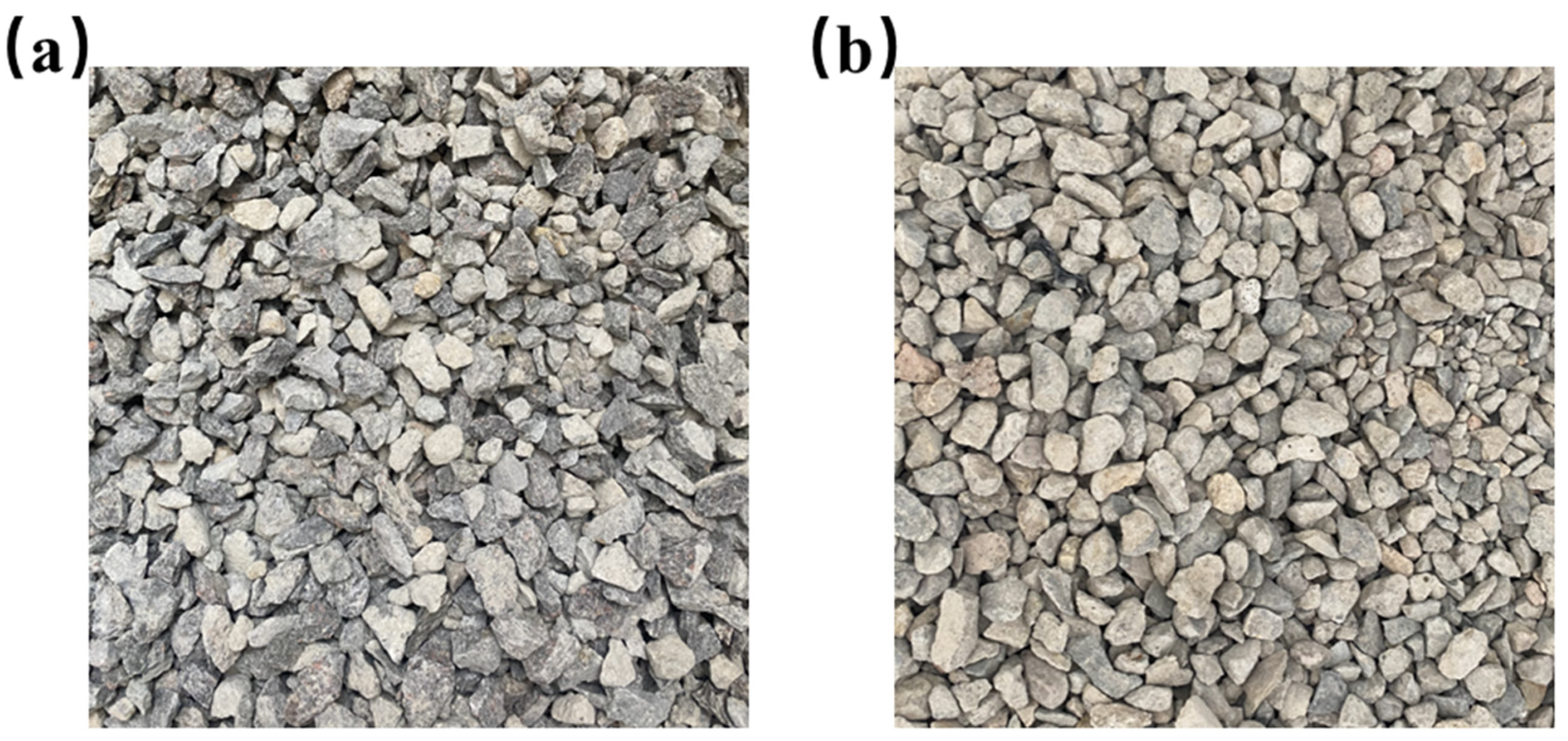
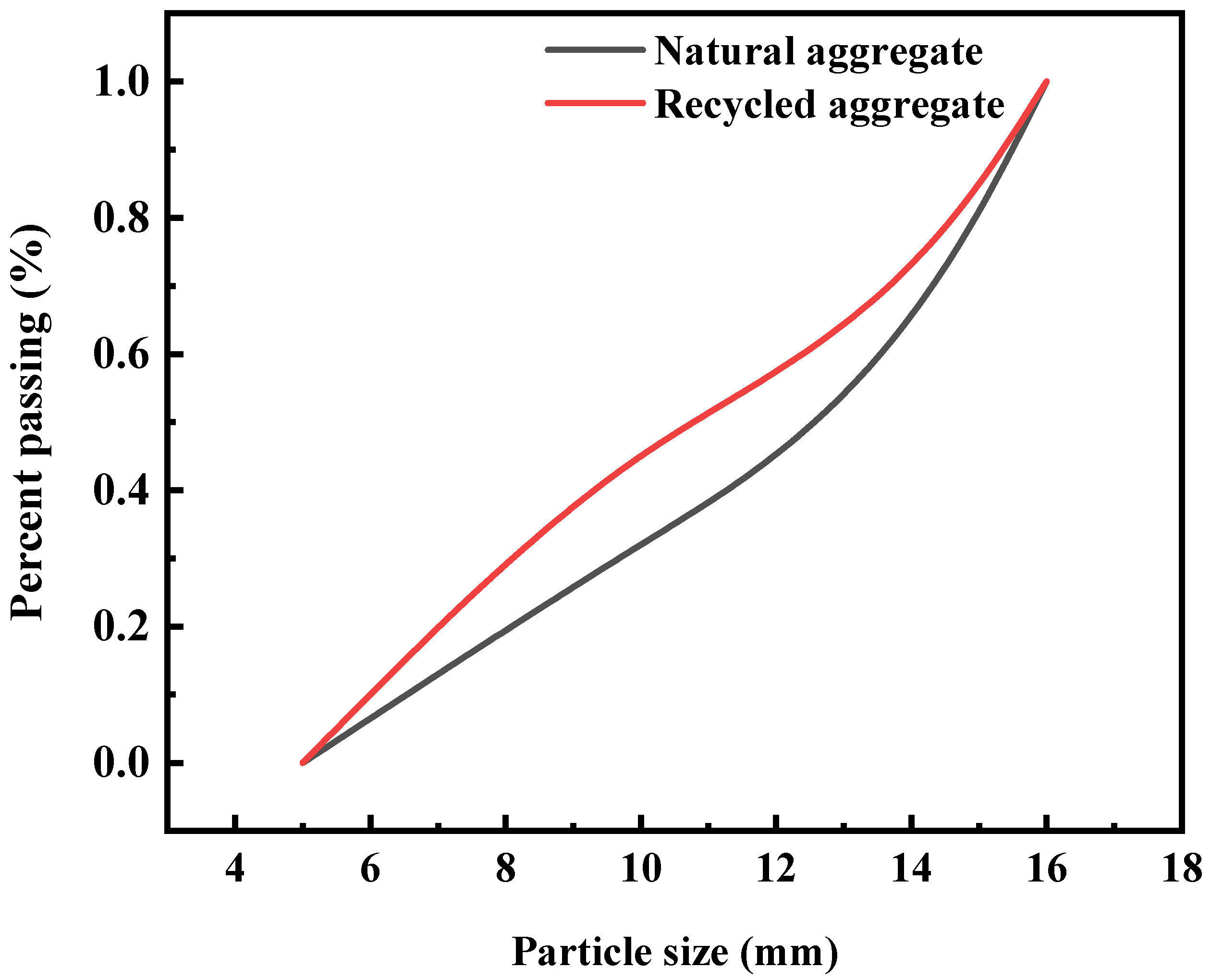
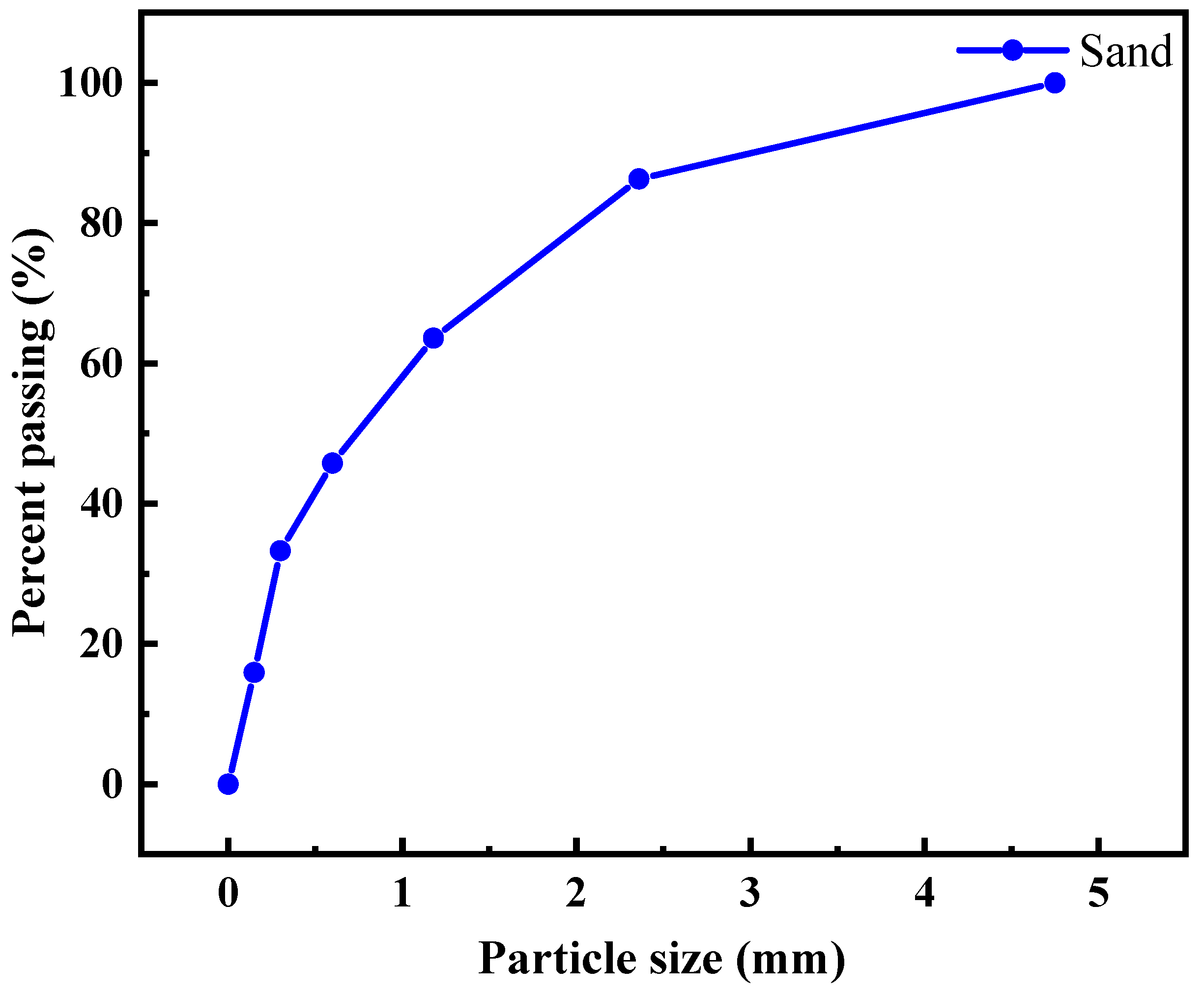
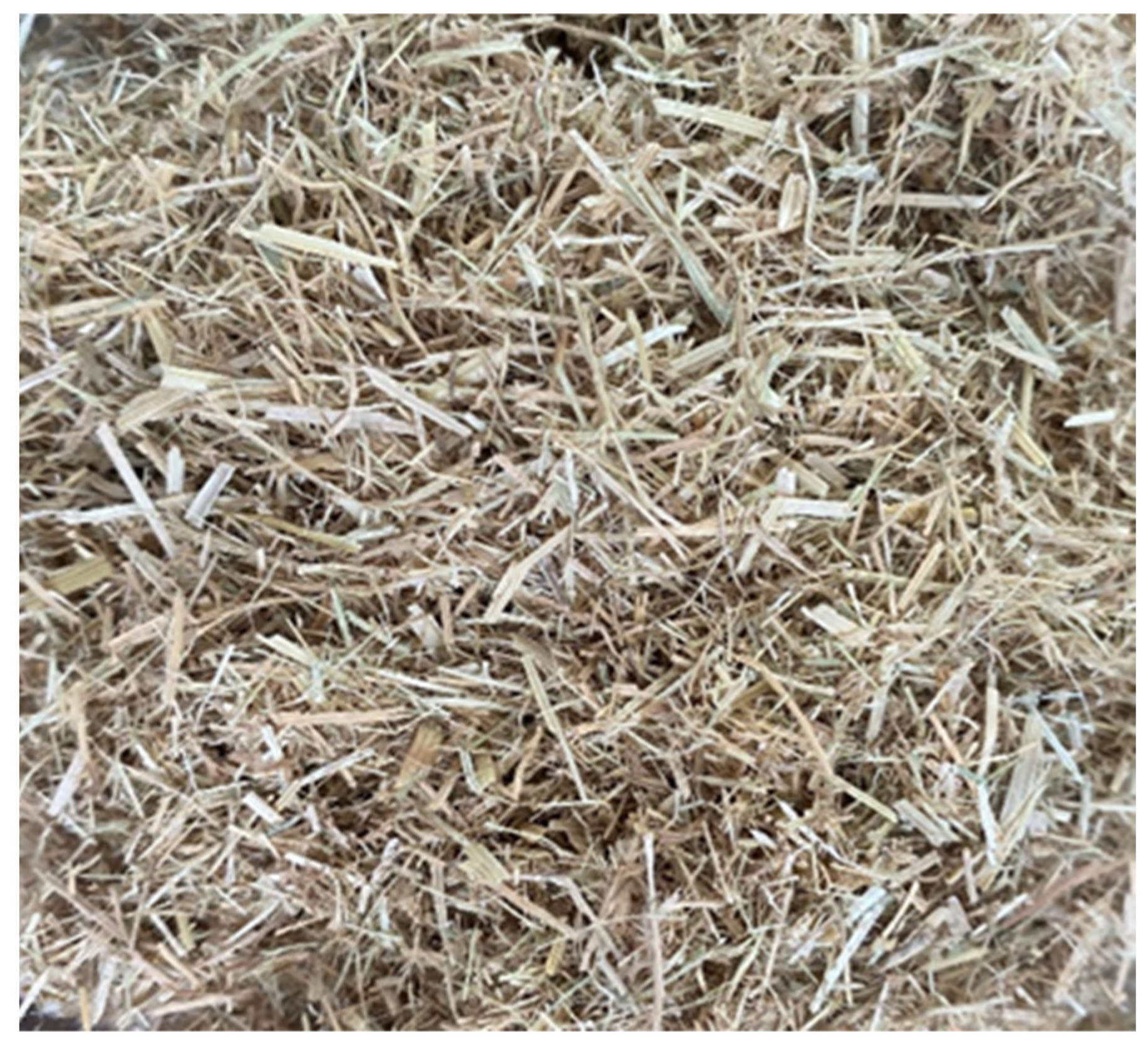

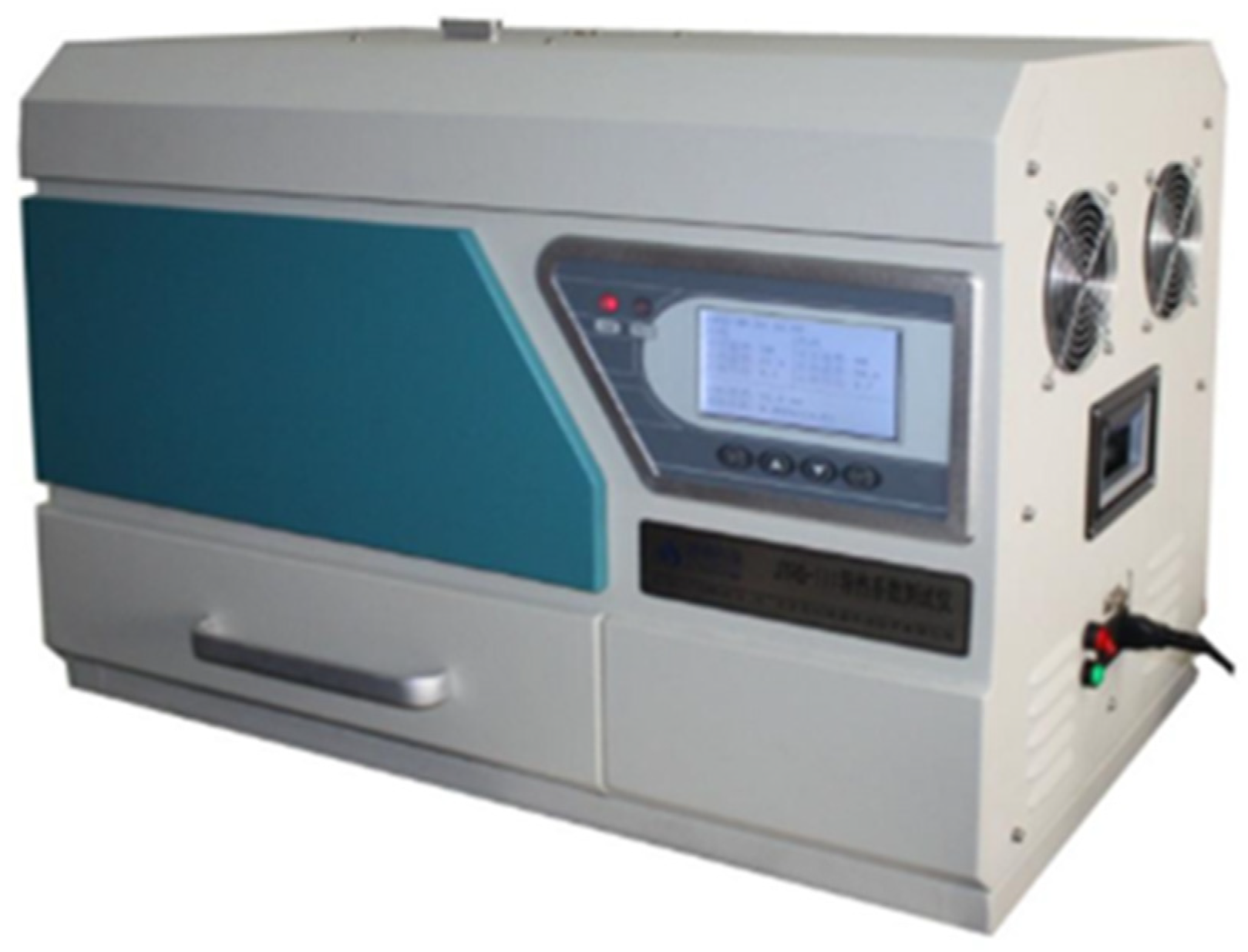

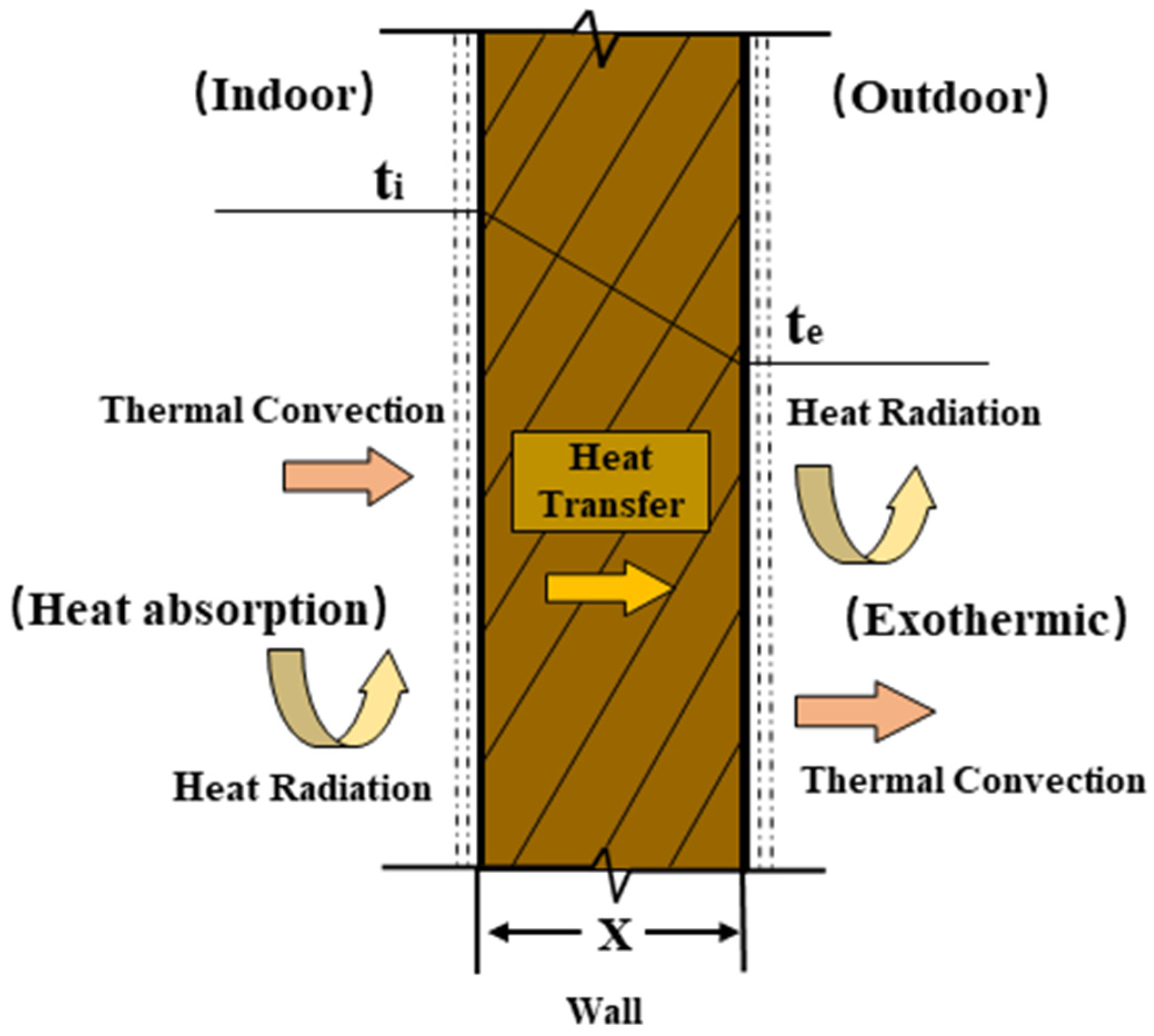
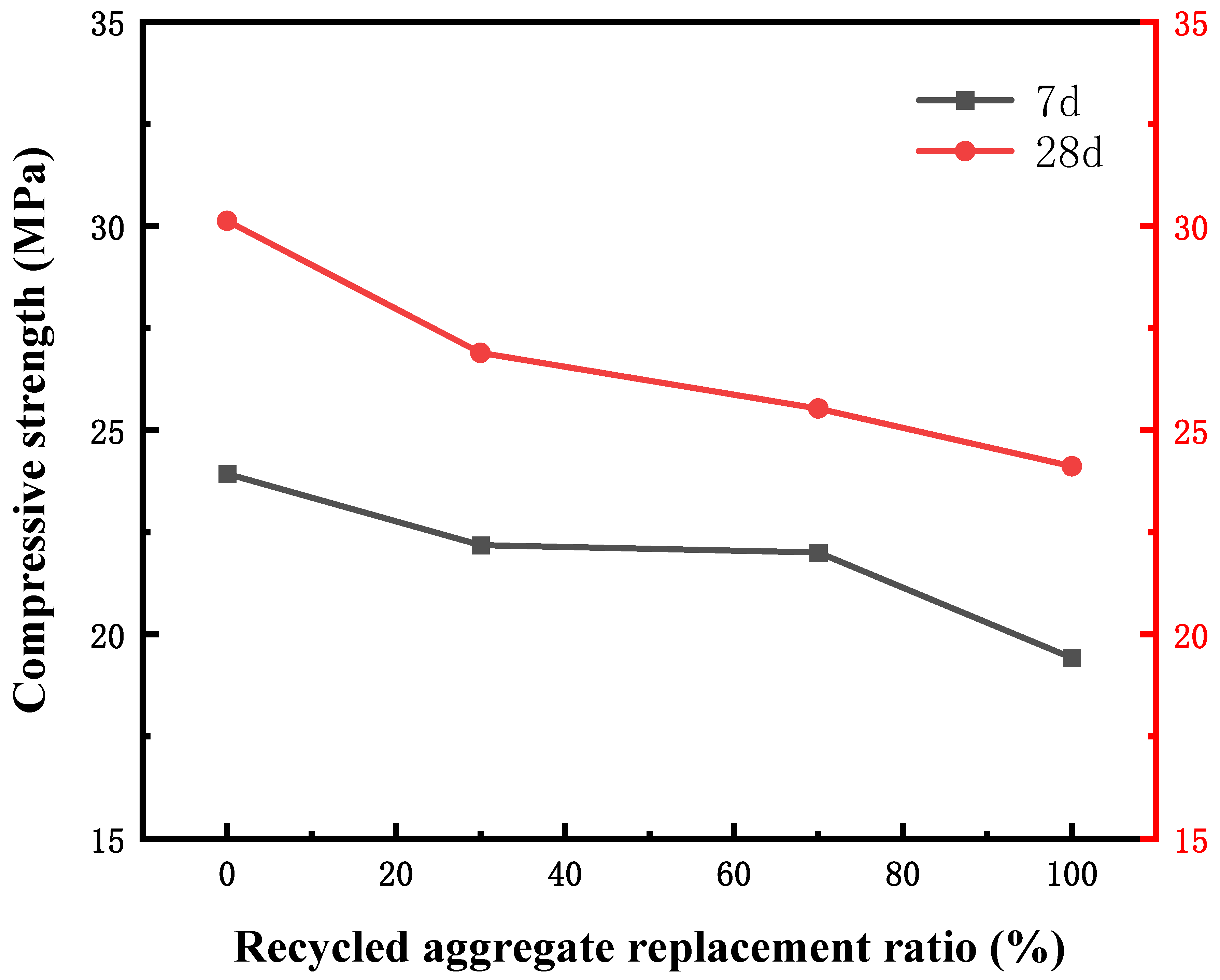

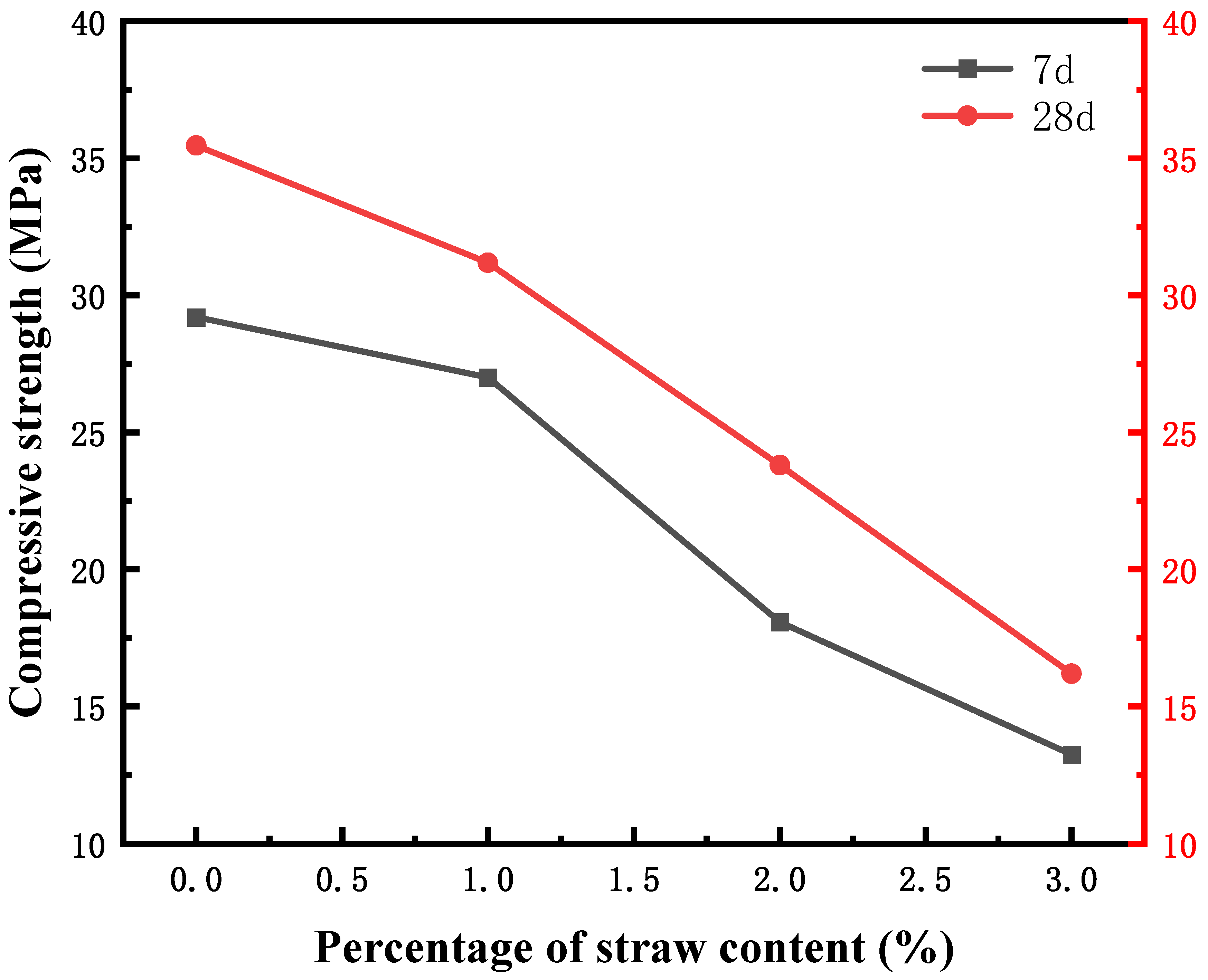
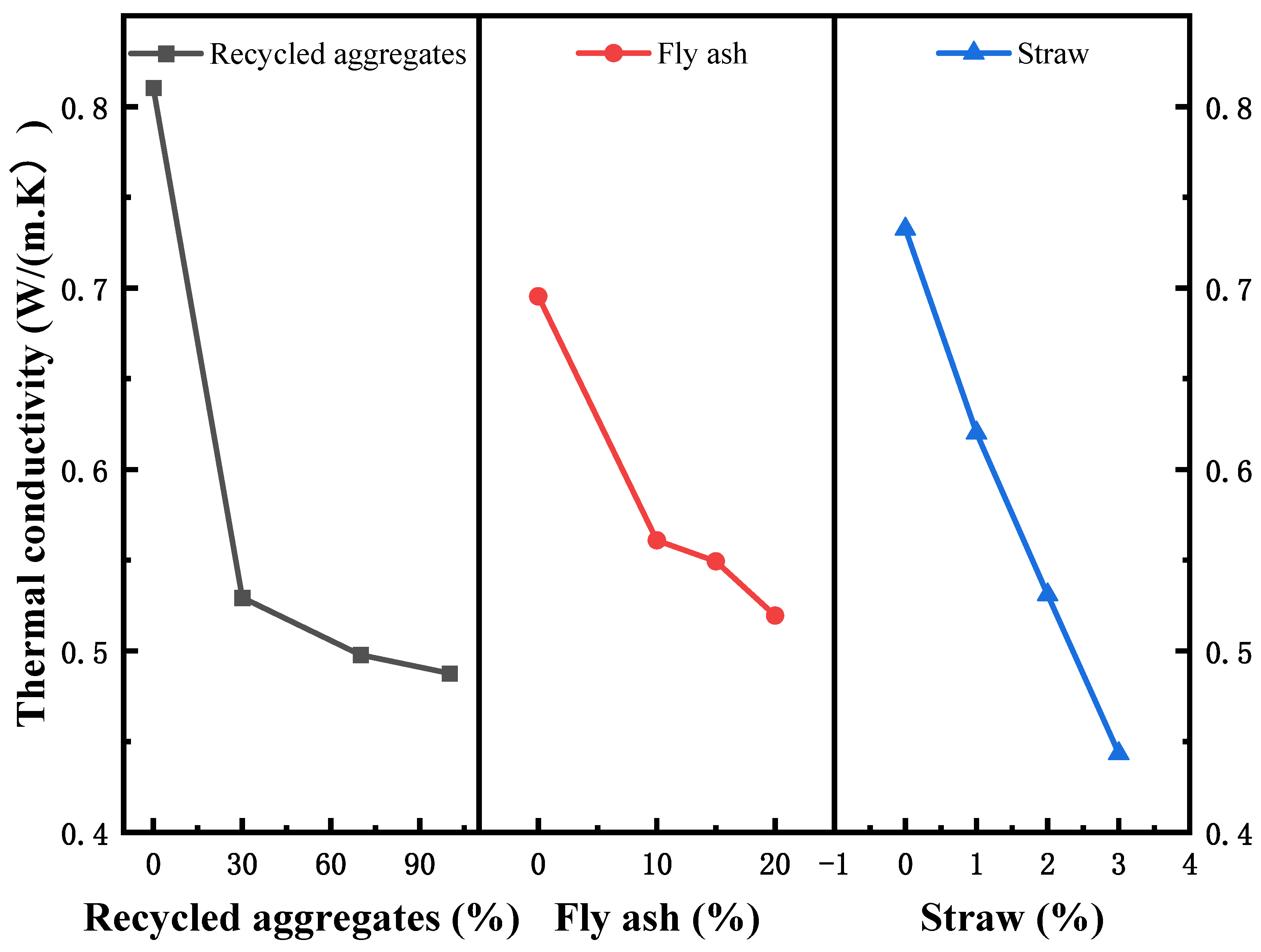
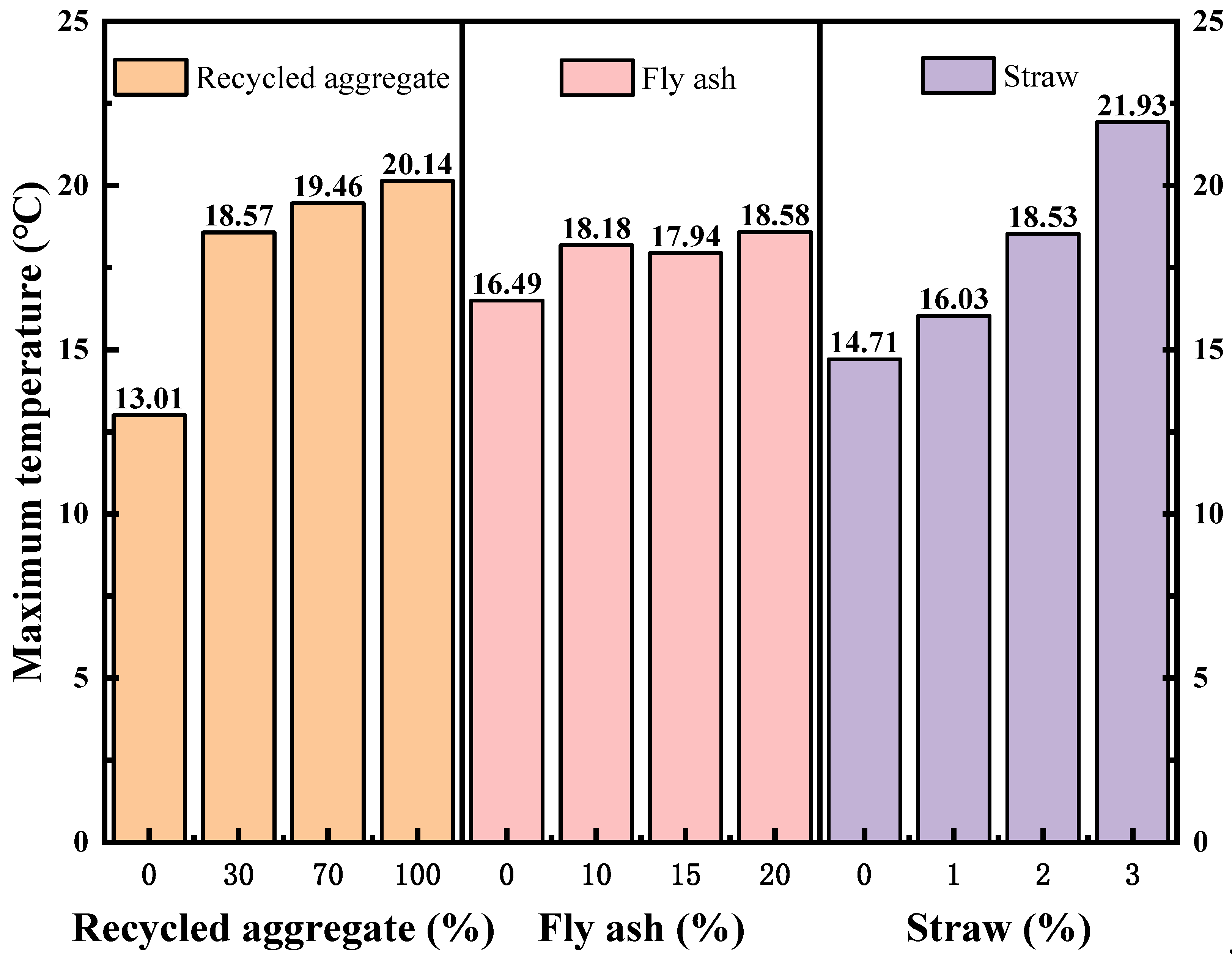
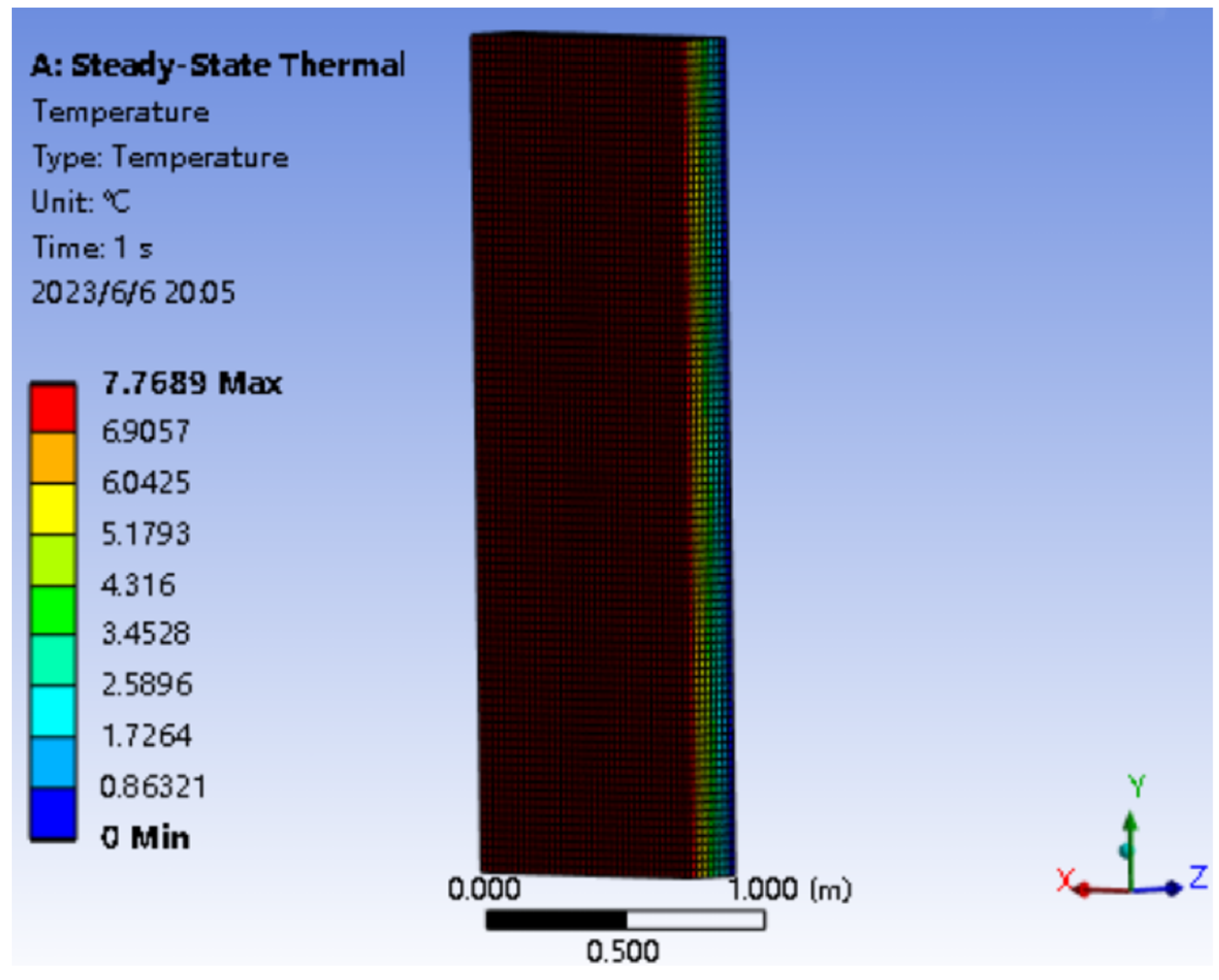
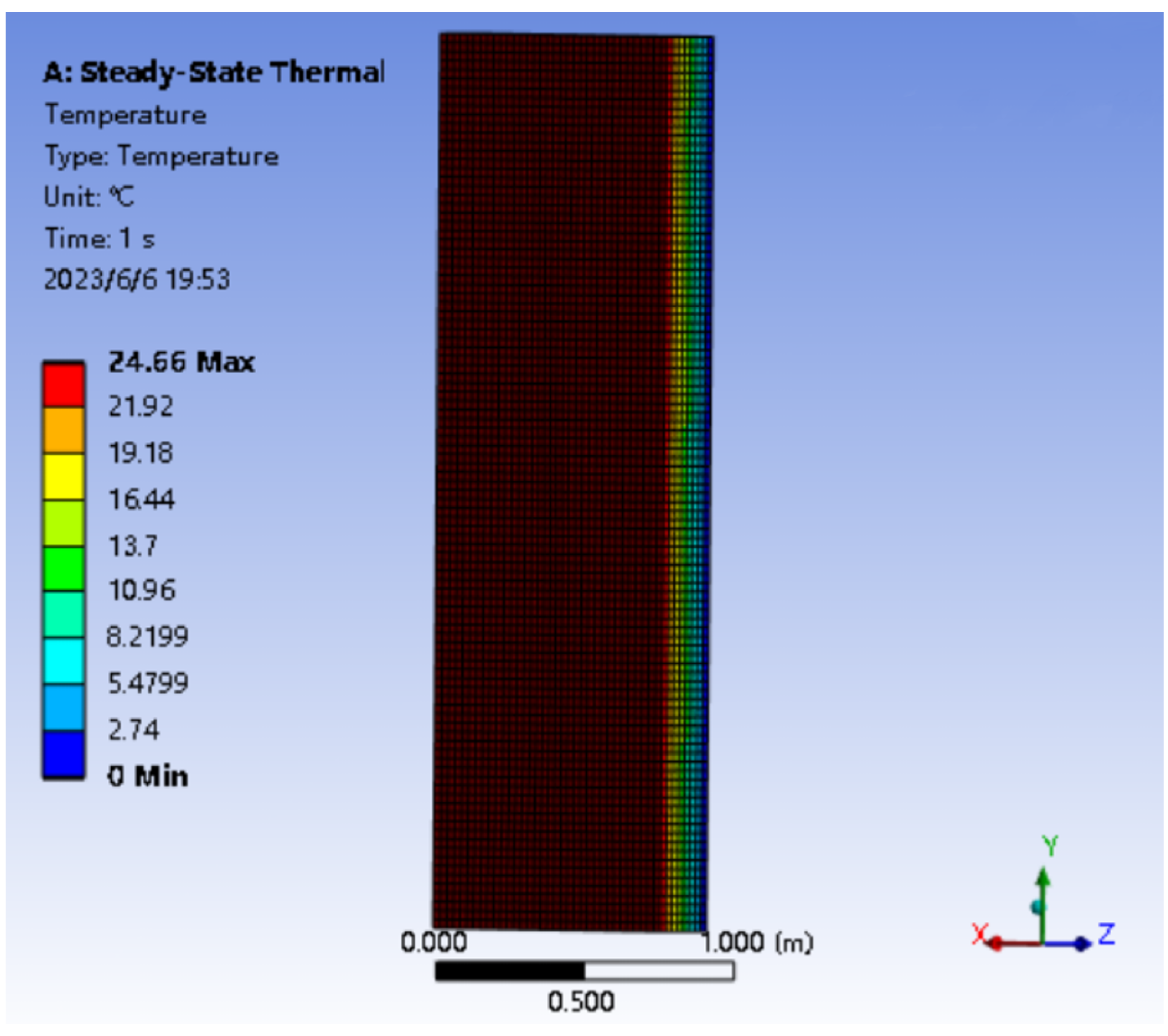
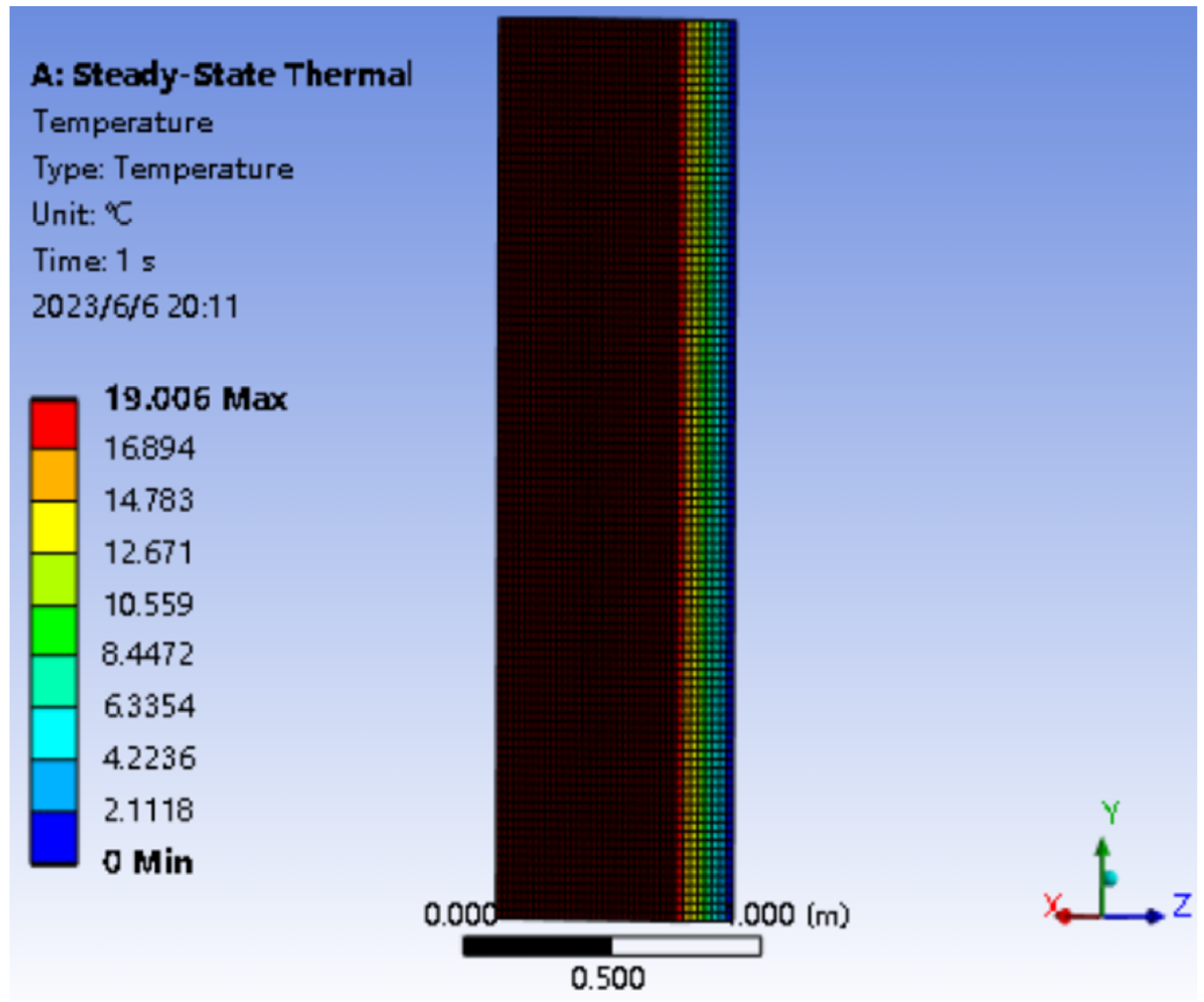
| Components | SiO2 | CaO | Al2O3 | Fe2O3 | SO3 | MgO | Loss |
|---|---|---|---|---|---|---|---|
| Content/% | 20.30 | 60.39 | 5.10 | 4.30 | 2.24 | 2.57 | 2.1 |
| Components | SiO2 | Al2O3 | CaO | SO3 | Fe2O3 | Loss |
|---|---|---|---|---|---|---|
| Content/% | 45.1 | 24.2 | 5.6 | 2.1 | 1.0 | 2.8 |
| Dry Bulk Density/(kg.m3) | Wet Bulk Density/(kg/m3) | Loose Bulk Density/(kg/m3) | Compacting Bulk Density /(kg/m3) | Porosity/% | Mass of Water Absorption/% | Volume of Water Absorption/% | Thermal Conductivity (W/(m·K)) |
|---|---|---|---|---|---|---|---|
| 191 ± 17 | 108 ± 6 | 164 ± 13 | 164 ± 13 | 82 ± 5 | 353 ± 16 | 207 ± 23 | 0.09 |
| Materials | Water (kg/m3) | Cement (kg/m3) | Fine Aggregate (kg/m3) | Natural Coarse Aggregate (kg/m3) |
|---|---|---|---|---|
| Content | 220 | 440 | 643.8 | 1096.2 |
| Factors | Recycled Coarse Aggregate Replacement Ratio (A)/% | Fly Ash Replacement Ratio (B)/% | Straw Content (C)/% | |
|---|---|---|---|---|
| Level | ||||
| 1 | 0 | 0 | 0 | |
| 2 | 30 | 10 | 1 | |
| 3 | 70 | 15 | 2 | |
| 4 | 100 | 20 | 3 | |
| Number | Orthogonal Test | Cement (kg/m3) | Fine Aggregate (kg/m3) | Natural Coarse Aggregate (kg/m3) | Recycled Coarse Aggregate (kg/m3) | Fly Ash (kg/m3) | Straw(kg/m3) | Net Water Consumption (kg/m3) | Additional Water Consumption (kg/m3) |
|---|---|---|---|---|---|---|---|---|---|
| 1 | A1B1C1 | 440 | 643.8 | 1096.2 | 0 | 0 | 0 | 220 | 0 |
| 2 | A1B2C2 | 396 | 643.8 | 1096.2 | 0 | 44 | 4.4 | 220 | 13.2 |
| 3 | A1B3C3 | 374 | 643.8 | 1096.2 | 0 | 66 | 8.8 | 220 | 26.4 |
| 4 | A1B4C4 | 352 | 643.8 | 1096.2 | 0 | 88 | 13.2 | 220 | 39.6 |
| 5 | A2B1C2 | 440 | 643.8 | 767.34 | 328.86 | 0 | 4.4 | 220 | 20.76 |
| 6 | A2B2C1 | 396 | 643.8 | 767.34 | 328.86 | 44 | 0 | 220 | 7.56 |
| 7 | A2B3C4 | 374 | 643.8 | 767.34 | 328.86 | 66 | 13.2 | 220 | 47.16 |
| 8 | A2B4C3 | 352 | 643.8 | 767.34 | 328.86 | 88 | 8.8 | 220 | 33.96 |
| 9 | A3B1C3 | 440 | 643.8 | 328.86 | 767.34 | 0 | 8.8 | 220 | 44.05 |
| 10 | A3B2C4 | 396 | 643.8 | 328.86 | 767.34 | 44 | 13.2 | 220 | 57.25 |
| 11 | A3B3C1 | 374 | 643.8 | 328.86 | 767.34 | 66 | 0 | 220 | 17.65 |
| 12 | A3B4C2 | 352 | 643.8 | 328.86 | 767.34 | 88 | 4.4 | 220 | 30.85 |
| 13 | A4B1C4 | 440 | 643.8 | 0 | 1096.2 | 0 | 13.2 | 220 | 64.81 |
| 14 | A4B2C3 | 396 | 643.8 | 0 | 1096.2 | 44 | 8.8 | 220 | 51.61 |
| 15 | A4B3C2 | 374 | 643.8 | 0 | 1096.2 | 66 | 4.4 | 220 | 38.41 |
| 16 | A4B4C1 | 352 | 643.8 | 0 | 1096.2 | 88 | 0 | 220 | 25.21 |
| Number | Recycled Aggregates (A)/% | Fly Ash (B)/% | Straw (C)/% | 7 d Compressive Strength/(MPa) | 28 d Compressive Strength/ (MPa) | Thermal Conductivity/ [W/(m·K)] |
|---|---|---|---|---|---|---|
| 1 | 0 | 0 | 0 | 35.23 | 42.44 | 0.7846 |
| 2 | 0 | 10 | 1 | 30.77 | 34.55 | 0.6812 |
| 3 | 0 | 15 | 2 | 19.07 | 28.43 | 0.5760 |
| 4 | 0 | 20 | 3 | 10.63 | 15.06 | 0.4990 |
| 5 | 30 | 0 | 1 | 30.11 | 32.72 | 0.6351 |
| 6 | 30 | 10 | 0 | 29.10 | 35.12 | 0.5591 |
| 7 | 30 | 15 | 3 | 12.34 | 17.48 | 0.4329 |
| 8 | 30 | 20 | 2 | 17.17 | 22.04 | 0.4703 |
| 9 | 70 | 0 | 2 | 19.32 | 22.86 | 0.5215 |
| 10 | 70 | 10 | 3 | 16.18 | 15.78 | 0.4226 |
| 11 | 70 | 15 | 0 | 27.88 | 32.54 | 0.5418 |
| 12 | 70 | 20 | 1 | 24.65 | 30.93 | 0.5352 |
| 13 | 100 | 0 | 3 | 13.83 | 16.46 | 0.3893 |
| 14 | 100 | 10 | 2 | 16.76 | 21.87 | 0.4508 |
| 15 | 100 | 15 | 1 | 22.48 | 26.55 | 0.5289 |
| 16 | 100 | 20 | 0 | 24.61 | 31.56 | 0.5833 |
| Age | i | Recycled Aggregates (A) | Fly Ash (B) | Straw (C) |
|---|---|---|---|---|
| 7 d | 1 | 23.93 | 24.62 | 29.21 |
| 2 | 22.18 | 23.20 | 27.00 | |
| 3 | 22.01 | 20.44 | 18.08 | |
| 4 | 19.42 | 19.27 | 13.25 | |
| R | 4.51 | 5.36 | 15.96 | |
| Optimization | A1B1C1 | |||
| 28 d | 1 | 30.12 | 28.62 | 35.47 |
| 2 | 26.89 | 26.88 | 31.19 | |
| 3 | 25.53 | 26.25 | 23.80 | |
| 4 | 24.11 | 24.90 | 16.20 | |
| R | 6.01 | 3.72 | 19.72 | |
| Optimization | A1B1C1 | |||
| Age | Factors | SS | df | MS | F | CV | Sig |
|---|---|---|---|---|---|---|---|
| 7 d | Recycled Aggregate (A) | 41.359 | 3 | 13.786 | 4.964 | F0.01 (3, 6) = 9.78 | * |
| Fly ash (B) | 72.7 | 3 | 24.233 | 8.726 | F0.05 (3, 6) = 4.76 | * | |
| Straw (C) | 675.595 | 3 | 225.198 | 81.094 | F0.1 (3, 6) = 3.29 | ** | |
| e | 16.662 | 6 | 2.777 | F0.2 (3, 6) = 2.1 | |||
| e△ | 806.316 | 15 | |||||
| 28 d | Recycled aggregate (A) | 79.238 | 3 | 26.413 | 4.932 | F0.01 (3, 6) = 9.78 | * |
| Fly ash (B) | 28.658 | 3 | 9.553 | 1.784 | F0.05 (3, 6) = 4.76 | △ | |
| Straw (C) | 862.888 | 3 | 287.629 | 53.708 | F0.1 (3, 6) = 3.29 | ** | |
| e | 32.133 | 6 | 5.355 | F0.2 (3, 6) = 2.1 | |||
| e△ | 1002.917 | 15 | |||||
| Age | Recycled Aggregate (A) | Fly Ash (B) | Straw (C) | |
|---|---|---|---|---|
| 28 d | 1 | 0.8103 | 0.6954 | 0.7325 |
| 2 | 0.5294 | 0.5609 | 0.6172 | |
| 3 | 0.4978 | 0.5493 | 0.5320 | |
| 4 | 0.4877 | 0.5194 | 0.4434 | |
| R | 0.3227 | 0.1760 | 0.2890 | |
| Optimization | A4B4C4 | |||
| Age | Factors | SS | df | MS | F | CV | Sig |
|---|---|---|---|---|---|---|---|
| 28 d | Recycled aggregate (A) | 0.284 | 3 | 0.095 | 7.45 | F0.01 (3, 6) = 9.78 | ** |
| Fly ash (B) | 0.073 | 3 | 0.024 | 1.922 | F0.05 (3, 6) = 4.76 | △ | |
| Straw (C) | 0.182 | 3 | 0.061 | 4.79 | F0.1 (3, 6) = 3.29 | * | |
| e | 0.076 | 6 | 0.013 | F0.2 (3, 6) = 2.1 | |||
| e△ | 0.615 | 15 | |||||
| Number | 28 d Compressive Strength (MPa) | Thermal Conductivity [W/(m·K)] | Total Efficacy Coefficient |
|---|---|---|---|
| 1 | 42.44 (1.000) | 1.2357 (0.315) | 0.561 |
| 2 | 34.55 (0.814) | 0.7912 (0.492) | 0.633 |
| 3 | 28.43 (0.670) | 0.6854 (0.568) | 0.617 |
| 4 | 15.06 (0.355) | 0.5289 (0.736) | 0.511 |
| 5 | 32.72 (0.771) | 0.6351 (0.613) | 0.687 |
| 6 | 35.32 (0.832) | 0.5791 (0.672) | 0.748 |
| 7 | 17.48 (0.412) | 0.4329 (0.899) | 0.609 |
| 8 | 22.04 (0.519) | 0.4703 (0.828) | 0.656 |
| 9 | 22.86 (0.539) | 0.5215 (0.746) | 0.634 |
| 10 | 15.78 (0.372) | 0.4226 (0.921) | 0.585 |
| 11 | 32.54 (0.767) | 0.5418 (0.718) | 0.742 |
| 12 | 30.93 (0.729) | 0.5051 (0.771) | 0.749 |
| 13 | 16.46 (0.388) | 0.3893 (1.000) | 0.623 |
| 14 | 21.87 (0.515) | 0.4508 (0.863) | 0.667 |
| 15 | 26.55 (0.626) | 0.5372 (0.725) | 0.673 |
| 16 | 31.56 (0.744) | 0.5733 (0.679) | 0.711 |
| Number | Thermal Conductivity [W/(m·K)] | Maximum Temperature (°C) |
|---|---|---|
| 1 | 1.2357 | 7.77 |
| 2 | 0.7912 | 12.13 |
| 3 | 0.6854 | 14.00 |
| 4 | 0.5289 | 18.15 |
| 5 | 0.6351 | 15.12 |
| 6 | 0.5791 | 16.58 |
| 7 | 0.4329 | 22.18 |
| 8 | 0.4703 | 20.41 |
| 9 | 0.5215 | 18.41 |
| 10 | 0.4226 | 22.72 |
| 11 | 0.5418 | 17.72 |
| 12 | 0.5051 | 19.01 |
| 13 | 0.3893 | 24.66 |
| 14 | 0.4508 | 21.29 |
| 15 | 0.5372 | 17.87 |
| 16 | 0.5733 | 16.75 |
Disclaimer/Publisher’s Note: The statements, opinions and data contained in all publications are solely those of the individual author(s) and contributor(s) and not of MDPI and/or the editor(s). MDPI and/or the editor(s) disclaim responsibility for any injury to people or property resulting from any ideas, methods, instructions or products referred to in the content. |
© 2023 by the authors. Licensee MDPI, Basel, Switzerland. This article is an open access article distributed under the terms and conditions of the Creative Commons Attribution (CC BY) license (https://creativecommons.org/licenses/by/4.0/).
Share and Cite
Deng, J.-X.; Li, X.; Li, X.-J.; Wei, T.-B. Research on the Performance of Recycled-Straw Insulating Concrete and Optimization Design of Matching Ratio. Sustainability 2023, 15, 9608. https://doi.org/10.3390/su15129608
Deng J-X, Li X, Li X-J, Wei T-B. Research on the Performance of Recycled-Straw Insulating Concrete and Optimization Design of Matching Ratio. Sustainability. 2023; 15(12):9608. https://doi.org/10.3390/su15129608
Chicago/Turabian StyleDeng, Jun-Xi, Xiao Li, Xiao-Juan Li, and Tai-Bing Wei. 2023. "Research on the Performance of Recycled-Straw Insulating Concrete and Optimization Design of Matching Ratio" Sustainability 15, no. 12: 9608. https://doi.org/10.3390/su15129608
APA StyleDeng, J.-X., Li, X., Li, X.-J., & Wei, T.-B. (2023). Research on the Performance of Recycled-Straw Insulating Concrete and Optimization Design of Matching Ratio. Sustainability, 15(12), 9608. https://doi.org/10.3390/su15129608





